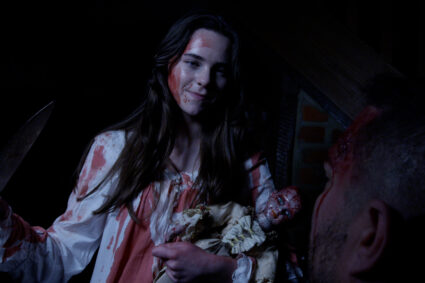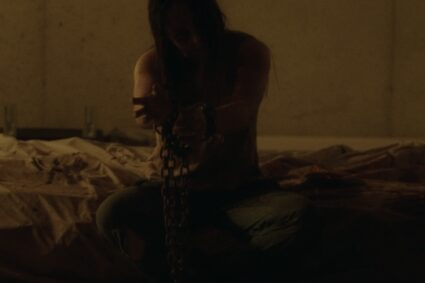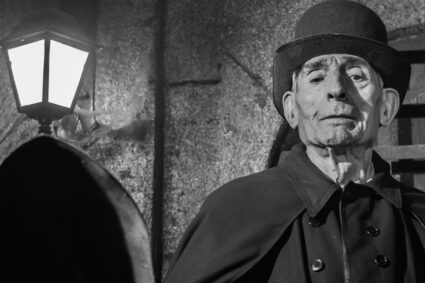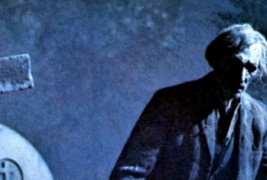
Welcome back, fear freaks! I’ve missed you. Is the reverse true? Really? Too bad, you’re stuck with me anyway!
Where were we last time? Oh yes, discussing the subject of horror anthologies in film! Let us continue down this gruesome path a bit further now. When last I left you, we had taken a look at 1964’s Japanese entry into the anthology sweepstakes, Kwaidan. Up to that point in time, the multi-story horror format was pretty rare, with only a few such films being made. But in 1965, the lid blew off the genre with the arrival of Amicus Productions from England. These industrious competitors to Hammer Studios had no luck with major characters such as Dracula, Frankenstein and the Mummy, because Hammer had locked them up. So they experimented with a film called Dr. Terror’s House of Horrors, starring no less than Peter Cushing himself. This entertaining montage featured Cushing as a malevolent character using tarot cards to show the evil fates of several passengers.
The film was a mild success and Amicus realized it had found a type of horror it could sink its fangs into. To this day, no other studio has become so identified with the horror anthology genre. A torrent of anthologies poured forth from Amicus, including The House That Dripped Blood, Torture Garden (featuring Burgess Meredith and Jack Palance), Asylum and From Beyond the Grave. All of these were entertaining in their own ways, but there were two films that towered above them all: Tales From the Crypt and Vault of Horror.
These two movies were truly titans of the horror anthology realm. To this day, 1972’s Tales From the Crypt remains the definitive horror anthology in the public eye. The film took gruesome tales from the old EC comic book of the same name and gave them a British twist. The direction from Freddy Francis, who helmed many suspense and horror chillers, was flawless and the movie featured a stellar cast that tore into their roles with gusto. So iconic has Tales from the Crypt become that I will now focus on it intensely as part of our little diatribe
TALES FROM THE CRYPT (1972)
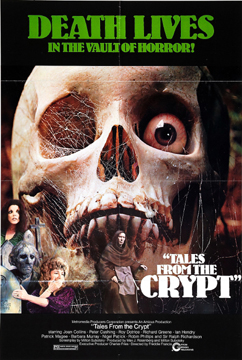
Those accustomed to the cartoony, often campy treatment of horror featured in the long-running HBO series might be put off by the more somber, realistic treatment given here. Instead of being portrayed by a cackling puppet spouting bad puns, the Crypt-Keeper who serves as the host is played with restraint by the acclaimed Sir Ralph Richardson. Personally, I find Richardson’s macabre monk spookier than the puppet.
Our story begins with a tour of morbid English catacombs. Five strangers suddenly find themselves separated from the main tourist group and lost. They make their way into a strange hidden chamber where a grim-faced old man in monk’s robes awaits them. They have been expected. The outraged tourists demand to know what is going on. “I have a purpose,” intones the Crypt-Keeper, who approaches Joanne Clayton (Joan Collins). Mrs. Clayton suddenly experiences a vision…and so begins our first tale.
And All Through the House
It is Christmas Eve and Joanne Clayton has just murdered her husband by braining him with a fireplace poker. Now she has to clean up the blood and conceal the body…all with her young daughter sleeping upstairs and waiting for Santa Claus to arrive. Festive Christmas songs play on the radio as Joanne carefully wipes up the copious blood from the killing. Suddenly, the music is interrupted by a news bulletin: a homicidal maniac has escaped from the nearby asylum and is on the loose. Reports say the maniac may be wearing a Santa Claus costume. Just then, Joanne sees a grotesquely leering face with red cap and shoddy white beard in the window. The killer is here! But if she calls the police, they’ll find her husband’s body. So Joanne must fight for her life on her own, against a fiend disguised as Jolly Old Nick…
This is the least of the five tales but it still has its grim charms. For one, Joan Collins is in her genuinely “hot” phase as Joanne Clayton. Second, the murder of her husband is a gruesome shock. I also like the constant accompaniment of holiday music to the scenes of terror and suspense. I thought the killer Santa could have been more menacing yet and while the ending is no surprise, it still has a disturbing edge to it. Looking at the way the stories are laid out, this serves as the perfect intro to the rest of them.
With Mrs. Clayton shocked into speechlessness by the vision the Crypt-Keeper has shown her, the cadaverous monk next turns his attention to businessman Carl Maitland (Ian Hendry). His tale now unfolds…
Reflection of Death
Carl Maitland seems to be a successful businessman with a loving wife on the surface. But Maitland is hiding a secret: a beautiful mistress he keeps on the side. Maitland is now preparing to leave his wife and child behind, escaping to a new life with his mistress, Susan. The duo makes an illicit rendezvous and then leaves for the airport. But tragedy strikes when the car is violently forced off the road and crashes in a ravine.
A dazed and injured Maitland crawls from the wreckage. There is no sign of Susan. He staggers onto the highway and runs across a tramp. When the tramp looks up and sees Maitland, he screams in horror and flees. A motorist slows down to yell at Maitland, but then drives away in fear. What’s going on?! Maitland makes his way to his wife’s house and knocks on the door…when she opens it and sees him, she, too, screams in terror and locks the door.
We see everything from Maitland’s point of view as he now makes his way to Susan’s apartment, where he learns what has happened to her and also gets the answers he’s been looking for…even though they’re not what he wants to hear…
This is a modest tale that’s pretty easy to figure out, but Freddie Francis’ excellent direction really makes it work. The point of view shots he comes up with for Maitland after the crash are very well-done and dreadful anticipation over seeing just what has happened to the character is keen. It’s so keen that the actual make-up we see once Maitland’s face is reflected in a glass table is somewhat disappointing. But the story keeps things moving, the spooky feeling is strong and Ian Hendry is very good as the unfortunate Mr. Maitland.
The Crypt-Keeper now turns his steely gaze upon young Mr. James Elliott (Robin Phillips) and we see the evil concealed beneath his bland exterior…
Poetic Justice
James Elliott and his father Edward live in a well-to-do neighborhood that has only one glaring flaw as they see it: the humble presence of junkman Arthur Grimsdyke (Peter Cushing), an elderly widower who is beloved by the local children. James thinks the old man is bringing down property values with his collection of odds and ends and his fenced in ‘pound full of dogs. He becomes obsessed with getting rid of Grimsdyke and begins a campaign of deceit and innuendo to dispose of him.
Elliott destroys another neighbor’s prize rose garden, leading that neighbor to blame Grimsdyke’s beloved dogs, who are then taken away. Elliott also arranges for Grimsdyke to lose his part-time job and worst of all, he whispers to neighborhood mothers about how strange it is that the old man plays with children so much. Soon, the harmless old man is left alone in his house, friendless and abandoned….except for the spirit of his wife, whom he contacts by Ouija board.
Elliott delivers the final blow on Valentine’s Day, when he sends Grimsdyke hundreds of Valentine’s letters…each insulting him and wishing that he would die. This proves too much and Grimsdyke hangs himself. Elliott has won his battle…but one year later, on Valentine’s Day and the anniversary of Grimsdyke’s death, Elliott will receive a reckoning for what he has done. One might say that he receives…poetic justice.
This is the most fondly remembered segment of the movie and most of that is due to the incomparable Peter Cushing’s portrayal of Grimsdyke. The great actor had suffered a devastating loss prior to filming — the passing of his beloved wife — and the grief one sees in the Grimsdyke character is all too real. Also great is the fantastic make-up used on Cushing when he exacts his revenge on Elliott — the best that time could offer. All in all, it’s a grimly satisfying story of revenge beyond the grave.
Shaken, Elliott withdraws from the Crypt-Keeper and now the focus turns to Ralph Jason (Richard Greene)…
Wish You Were Here
Ruthless businessman Ralph Jason, who has been involved in many shady deals, including gun-running, is finally out of luck. His lawyer and friend Charles Gregory informs him that he’s out of money and bankruptcy is the only option. Devastated, Jason’s wife Enid wonders how she’ll cope without money…when her attention is drawn by a curious statue of the Chinese god of luck that is amongst their collection. An inscription on the base says that 3 wishes can be asked of the god…and 3 wishes only.
Enid idly wishes for money and almost instantly, a phone call from Gregory urgently asks Jason to meet him. Jason gets in his car to make the trip, but soon notices he is being tailed by an ominous leather-clad motorcyclist. He is even more horrified when he sees the cyclist has the grinning skull of death himself! Soon, Enid learns that Jason has died in a road accident…but she is now the beneficiary of Jason’s insurance. She has her money.
Enid’s next wish to for Jason to return just the way he was before the accident. There is a knock on her door. Four silent pallbearers carrying a coffin enter and leave the coffin. Jason is inside the coffin, dead. He had actually died of a heart attack just before the actual wreck and has been returned in exactly that condition. Overcome by grief and against the advice of Gregory, Enid makes her final wish…that Jason return to life and that he live forever. She has that wish realized as well…in the most horrifying fashion possible.
This segment is certainly the most gruesome and gory, if not the best written. The debt to the classic story The Monkey’s Paw is obvious and alluded to by the characters here in a conversation. If any story is going to “gross out” the viewer, this will be it, even though the ending seems shrill and hysterical. Certainly Ralph Jason’s fate is the most horrible of all 5 characters.
The final member of the tourist group is Major Rogers (Nigel Patrick) and the Crypt Keeper now turns his malevolent gaze to him…
Blind Alleys
Major Rogers is a severe former military man who has been hired to run a home for impoverished blind men. Rogers immediately enacts his harsh form of military discipline on the men and also cuts back drastically on their comforts, including food and warm blankets. While Rogers dines on steak in a room fitted with art and luxury items, the blind men eat barely edible slop and shiver in the cold. The leader of the residents, Carter (Patrick Magee), tries to inform Rogers that the men are suffering under his rule, but he’s run out of Rogers’ office by his vicious dog, Shane.
Finally, a friend of Carter’s dies due to severe cold, which doesn’t seem to bother Rogers at all. A light goes on in Carter’s head and the blind men plan an elaborate revenge on their tormentor. First, Shane is lured to a basement closet where he’s locked in and starved to a state of rabid hunger. Next, the residents manage to knock out Rogers and imprison him in a cellar room next to Shane. Rogers hears the sound of carpentry as the blind men feverishly work on some project. Carter keeps Rogers in the dark but tells him he will find out exactly what is going on in due time.
Finally, the door to the Major’s room is opened…and he exits to find himself facing a wooden corridor with hundreds of deadly sharp razorblades embedded in it. He will soon find himself faced with running through a “Blind Alley”.
This is my personal favorite of the stories, despite its lack of supernatural elements and monsters. Of course, the whole premise of blind men creating such a demonic, painstaking revenge is absurd, but you suspend your disbelief when you venture into Tales from the Crypt and the whole scenario is deliciously twisted. It would be a pretty hard viewer who doesn’t wince at Rogers’ final fate.
What really makes the segment work so well is the great performance of Patrick Magee as Carter, spokesman for the blind. How this cadaverous fellow, with his Karloff-like voice and facial structure, missed becoming a horror icon is beyond me, but his melodious, sinister tone is a delight to hear. I especially like his response when the trapped Rogers tells him that Shane must be fed: “He’ll be fed all right, Major Rogers…sir.”
The tales are over and the guests demand that the Crypt-Keeper tell them what’s going on. With relish, he tells them that the stories were not visions of the future, but relating the events that brought them to this place…”a place where those who die without repentance go.” Silently, the guests shuffle to their eternal demises, leaving the Crypt-Keeper to face the camera and intone, “Who’s next? Perhaps…you?”
The film was not only a commercial smash, but it garnered a surprising amount of critical acclaim, acclaim which I feel was well merited. The actors’ performances, the direction of Freddie Francis, the sleazy brilliance of the source material all combined to create the archetypal horror anthology. The movie was very quickly followed by the similar and nearly as good Vault of Horror, also from Amicus.
A few more anthology films followed, but by the end of the 70’s, the format had seemingly dried up. It got a shot in the arm in 1982 with the arrival of Creepshow. Like Tales From the Crypt, this movie was also inspired by classic EC Comics horror stories, but it would up being gorier and campier, with an American slant as opposed to the more “cultured” British approach. An all-star cast helped this one become a hit, but in the 80’s most horror anthologies were in the direct-to-video VHS format. A notable twist on the genre was Grim Prairie Tales, where Western themes were combined with horror. Unfortunately, 1985 saw the release of undoubtedly the worst anthology ever, Night Train To Terror, which was appallingly senseless…and highly recommended to aficionados of total schlock.
1995 featured one of the most unique takes on the horror anthology, one that was very traditional in some ways, but utterly different in others. It was Tales from the Hood and this is the next film I plan on focusing on in depth…
TALES FROM THE HOOD (1995)
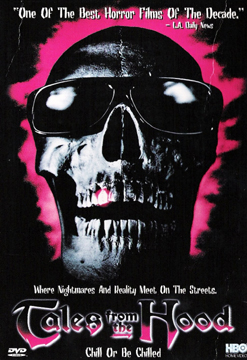
As you might be able to guess from the title, this movie took the classic multi-story format of Tales from the Crypt and moved it into the gritty African-American milieu of such 90’s crime tales as Boyz In The Hood and New Jack City. It’s a combination of supernatural shock with real-life horror and it works surprisingly well. Maverick film maker Spike Lee helped produce the movie, but the guiding hand belonged to director Rusty Cundieff, who assembled a good cast and put a lot of Hollywood flash into the film. In fact, I’m guessing one segment from Tales from the Hood probably cost more than the entire 1972 Tales from the Crypt.
The movie’s framing sequence begins in the gang-ridden streets of South Central L.A., where 3 hardcore bangers named Bulldog, Stack and Ball arrive at the funeral home run by the creepy Mr. Simms (Clarence Williams III). Mr. Simms is this movie’s version of the Crypt-Keeper. The gangsters are in search of drugs hidden in the funeral home and they use force to have Simms help find them. But Mr. Simms not only stays unruffled, he relates macabre tales about some of his “customers” who met with grim death…
Rogue Cop Revelation
This first story deals with rookie police officer Clarence Smith, a black cop on a force dominated by racist white rogue policemen. Trouble starts for Clarence right away when he sees crusading civil rights activist and African-American Martin Morehouse pulled over by his fellow officers. Morehouse is savagely beaten, injected with heroin and then put inside a car that’s shoved into a nearby river along with more drugs planted in it. Morehouse not only drowns, but his reputation is ruined when people think him a drug-addicted hypocrite.
Clarence is threatened with death by the rogue cops and he keeps silence in shame. The incident has proved too much for him…he quits the force and becomes a bitter drunk. But exactly one year after Morehouse’s death, he has a vision of the dead crusader, who tells Clarence to “bring them to me”. Clarence arranges to have the 3 cops who killed Morehouse meet him at the grave of their victim.
As the cops dole out even more humiliation by urinating on the grave, the ground suddenly erupts and Morehouse’s decayed corpse rises. It’s time for revenge and the ghastly zombie hunts down and gruesomely disposes of those who murdered him while a stunned Clarence watches it all. At last, Morehouse turns to Clarence and asks, “Where were you when I needed you, brother?” Clarence is next seen screaming in an asylum, where he’s been sentenced for the brutal murder of 3 cops.
The story delivers in terms of gore and action, but logically doesn’t hold up very well. The deck seems too obviously stacked, with all cops but Clarence seeming to be ultra-bigoted and corrupt. Morehouse is kind of an analogy for Martin Luther King, but I can’t imagine King rising from the grave and decapitating James Earl Ray. The scenes of bloody vengeance are superficially satisfying, but superficial is indeed the best description.
Now Mr. Simms introduces his “captors” to another dead resident of the funeral home, a man named Carl who met a horrid death in a most peculiar way…
Boys Do Get Bruised
Elementary school teacher Mr. Garvey (director Rusty Cundieff himself) notices that young Walter is showing up to school bruised and hurting. When Garvey asks Walter what’s going on, he says that a “monster” hit him. Walter is shy and withdrawn, but whenever someone at school bullies him, they wind up getting injured in freak accidents.
Garvey investigates Walter’s situation on his own time and finds that the boy’s attractive single mother seems to be making light of his injuries. He doesn’t know that the mother’s new boyfriend Carl is a sadistic brute that is making life a living hell for both her and Walter. On Carl’s arm is a tattoo of the word “monster”.
Eventually, Garvey learns the truth and tries to intervene, but he also learns that Walter has a terrible secret power that allows him to take care of the “monster”…and anybody else he doesn’t like.
This story shifts gears 180 degrees from the first segment and shows a very surprising restraint and subtlety for a movie featuring gory horror and urban violence. But there is little more horrifying than child abuse, especially if you’re the child. The tale also touches on the dysfunctional family as a mainstay in the black community and bravely takes a stand. Gorehounds into pure blood and guts will likely be disappointed with this story, but I felt it gave the movie a real touch of class.
Carl gets what’s coming to him in devastating fashion, but one now wonders if sensitive Walter will become something like the demonic “Little Anthony” in the classic Twilight Zone episode It’s A Good Life.
Simms now shows the gangsters a grotesque looking doll instead of a body. When they ask him if he plays with dolls, the macabre mortician smiles and says “This ain’t no ordinary doll….”
KKK Comeuppance
Duke Metzger (Corbin Bernsen) is an obnoxious Southern politician who conceals a violently racist past from the public, including a stint with the KKK. Metzger is now trying to portray himself as a “progressive” and to prove this, he’s just moved into a former slave plantation with a haunted legend.
Duke tours the mansion with his black PR assistant and notices a portrait of an elderly African-American woman with a collection of 12 strange dolls. Duke is told that the woman was Mama Cobbs, a voodoo witch who took the souls of 12 slaves wrongly hanged for crimes committed by whites and transferred them into the dolls. The old woman is long dead, but the dolls are still said to lurk in the house, waiting to avenge themselves on the KKK. Metzger scoffs, but the assistant falls to his death down a long flight of stairs. We see the shadowy form of a doll lurking beneath the stairs.
Metzger refuses to heed the advice of those telling him to leave the plantation. He notices that one of the dolls is missing from the painting…and he’s soon attacked by the crazed and voracious plaything. A deadly cat-and-mouse game now ensues, pitting Duke against the doll. Eventually, Duke gets the upper hand and goes back to the painting to gloat…only to notice that now ALL the dolls are missing! Can the weaselly KKK man survive the vengeance of the voodoo dolls?
This story is purest in spirit to the EC Comics of old. An outrageously obnoxious character gets an outrageously grotesque supernatural comeuppance. This one is over the top and crazy but never less than entertaining. Experienced horror fans will notice a strong resemblance to the classic Trilogy of Terror episode where Karen Black was chased by a cannibal doll. The original Night Gallery movie had a segment where a painting came to life to deliver vengeance on a killer.
Tales from the Hood came out just before CGI really exploded, so the killer dolls are animated with what looks like old school stop motion animation…never a bad thing in my book. “Duke Metzger” is a name that takes a shot at two well-known racists…former KKK head Tom Metzger and politician David Duke. Corbin Bernsen has a great time playing this slime ball.
The gangsters are now getting anxious and are becoming unnerved by Mr. Simms’ tales. They put pressure on him to reveal the hiding place of the dope, but Simms first asks if they recognize the next body he shows them. They do…it belongs to a mad-dog gangbanger known as Crazy K…
Hardcore Convert
Crazy K is one of the most blood-thirsty criminals in all of LA, laying waste to black and white, young and old, with equal ferocity. Cruising the streets and looking for trouble, K gets into a shoot-out with rival gangsters. The police arrive and clamp down on the killers with force…K is badly wounded and the others killed.
K is patched up and thrown into prison, where he meets Dr. Cushing (Rosalind Cash), who removes him from the facility and takes him to a secret medical complex inhabited by other hardcore killers and criminals. Dr. Cushing intends to put K through a special treatment designed to cure him of homicidal tendencies. If it works, there’s a chance he can walk free again. But Cushing warns him that the procedure is grueling and painful, both physically and mentally.
In scenes reminiscent of Alex’s treatment in A Clockwork Orange, Crazy K is exposed to images of atrocities like KKK lynchings and Nazi concentration camps. Then he is shown footage of gang violence on the streets…and finally images of all the victims he himself has killed. Dr. Cushing lashes him with bitter words: “How many of your brothers have you killed?”
Crazy K is then put in a chamber where he is confronted by the spirits of his victims. He must answer their questions as to why they had to die. Finally, a little girl appears and asks why K had to kill her. K rejects responsibility for his actions, panicking as the spirits demand remorse. Finally, he realizes his last chance for redemption has passed…and he must now face reality.
This is a powerful segment that merges the African-American gangster film with horror and science fiction in a clever way. There are a lot of real-life monsters like Crazy K out there and the black community in particular suffers from their violence. K gets his chance to repent but blows it. The scenes of horror shown during Cushing’s treatment are all the more horrible because they are real.
The segment can best be described as New Jack City meets A Clockwork Orange, but there are other influences. Any fan of Hammer horror will smile at the name “Dr. Cushing” (sadly, this was Rosalind Cash’s last role). I am also reminded of the great Twilight Zone episode Death’s Head Revisited, where a sadistic Nazi is tormented by the ghosts of concentration camp victims. A good scene comes when Crazy K is imprisoned with a violent white racist. K beats the racist into submission, but when the man asks the race of K’s victims, the gangster is silent: he knows he’s killed his own.
The telling of Crazy K’s story has triggered a horrible awareness in Stack, Ball and Bulldog. They realize that they were the gangsters shot to death by the police during the battle with K. Simms laughs and tells them “this AIN’T no funeral home,” as their bullets pass through him harmlessly. He has one final thing to show them…and for those who recall the ending of Tales from the Crypt, it will not be much of a surprise. Again, hats off to Clarence Williams III, the former Mod Squad star, who steals every scene he’s in as Mr. Simms.
Tales from the Hood proved to be a moderate success at the box office, but it’s achieved more notoriety during its video store run. It remains one of the more unusual attempts at a horror anthology.
Unfortunately, within the last 15 years, the horror anthology film has again gone into a slumber. From time to time, there are direct-to-video anthologies that are released, but we are a long way from the glory days of Amicus in the 60’s and 70’s.
With the technology now available to filmmakers and the lack of original ideas making short horror stories an ideal source of readymade material, it’s strange that the format has all but disappeared. One could hope that some enterprising studio will take a chance and once again open the doors to the horror anthology film.
I hope you humanoids have enjoyed this trek through the weird world of horror anthologies and I urge you to check out these films if you haven’t already done so…


